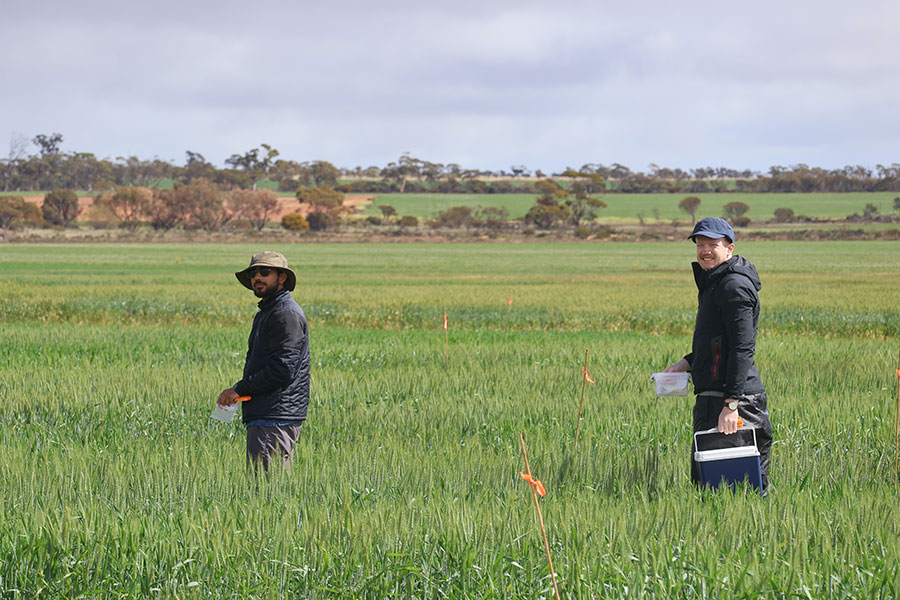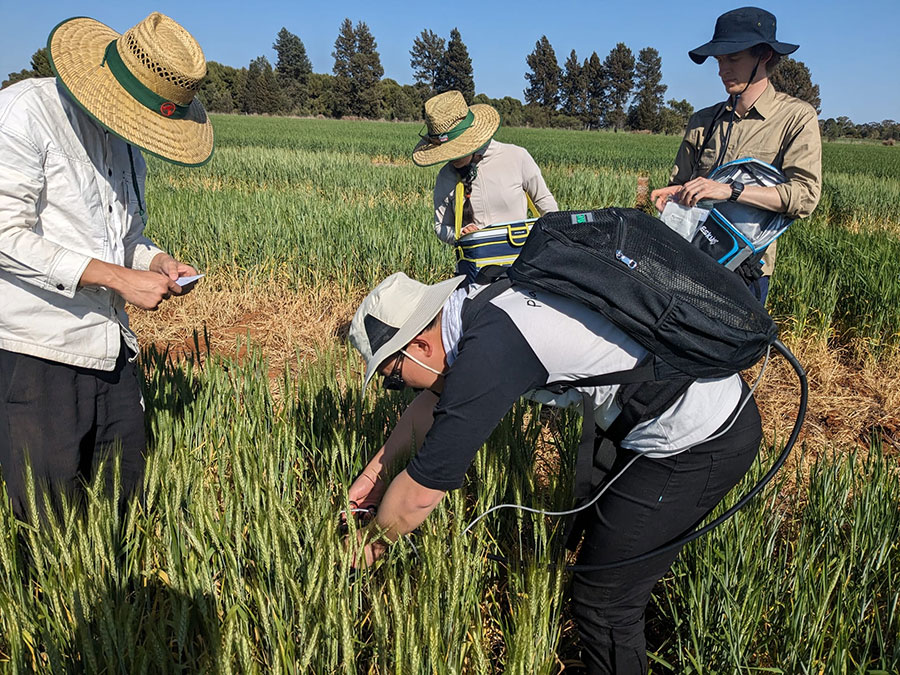The ability to mass screen wheat for differences in photosynthesis efficiency at high temperatures is being developed to give breeders a vital new selection tool
Photosynthesis in cereal crops today is a target for cutting-edge analysis to break through existing ceilings on yield potential. The reason is straight forward: photosynthesis makes energy available over and above what the plant needs to merely survive. It is that excess energy that enables the plant to grow and produce grain, making it a key determiner of yield potential.
Furthermore, the photosynthetic machinery is heat sensitive, making it a target for innovation to the heat tolerance levels of cereal crops. This too is an important determiner of yield potential.
Notably, however, photosynthesis has never been systematically targeted before by breeders. But it could be.
 Joy Ojo (left) and Hanna Amoanimaa-Dede take wheat physiology measurements during the 2023 season at the University of Sydney Plant Breeding Institute in Narrabri, NSW. Photo: Fiona Foster, the University of Sydney
Joy Ojo (left) and Hanna Amoanimaa-Dede take wheat physiology measurements during the 2023 season at the University of Sydney Plant Breeding Institute in Narrabri, NSW. Photo: Fiona Foster, the University of Sydney
Photosynthesis rates are known to vary due to diversity in the wheat gene pool and in environmental conditions. With the right tools, it should be possible to ‘phenotype’ (to test and rank) wheat populations relative to photosynthesis rates, including at high temperatures.
However, these tools and capability do not exist and need to be created.
Phenotyping requires assessing how efficiently plants convert sunlight into biological energy (sugars and ATP, the principal molecule for storing and transferring energy in cells). In turn, these conversion rates determine biomass and grain amounts. Once ranked, it is possible to select for the most efficient gene and trait combinations suitable for different environments.
This phenotyping capability is considered a matter of urgency for two reasons. First, it permits wheat lines to be screened for their tolerance to hot conditions, a key production constraint in Australia. Second, it is needed to increase yields so that wheat production can keep pace with population growth in a world where temperatures continue to rise.
Globally, yield increases for the past six decades have been found using traits associated with plant architecture (such as shorter plant height that reduces lodging and improves light interception). Combined with Green Revolution agronomy, these traits have delivered average annual yield gains of 0.5 to one per cent – an impressive feat.
However, given the rate of population growth, something closer to two to three per cent is needed. After an extensive review of plant physiology, an international consensus has opted to target photosynthesis and its response to heat.
With GRDC investment, a multi-institution team is working to translate a theoretical understanding of photosynthesis into new phenotyping capability.
The team is led by Professor Owen Atkin from the Australian National University (ANU), which is partnering with the University of Sydney, University of New England, University of Western Australia, University of Lancaster, Essex University, InterGrain and the International Maize and Wheat Improvement Center (CIMMYT).
The team’s specific target is to improve wheat’s heat tolerance in Australian growing conditions. Additionally, the team is translating this new capability into high-throughput technological platforms that breeders can use to develop better-performing varieties.

The sampling team from the University of Western Australia (from left): Agyeya Pratap and James Kelly. They are collecting flag leaves that will be tested and ranked for photosynthesis rates at the DPIRD Merredin Research Facility, WA. Photo: Nic Taylor
Targeting photosynthesis
To measure, rank and select for variation in photosynthesis efficiency, techniques are needed to deal with an extraordinary amount of biological complexity. There are strings of specialised enzymes involved that function in a coordinated fashion. There are even subcellular structures (chloroplasts and mitochondria) with intricate cell membranes that mediate delicate electrochemical processes.
All these cellular activities are highly sensitive to temperature – particularly the enzymes and membranes that underpin metabolism. Fortunately, the overall state of the intricate and heat-sensitive photosynthetic machinery can be assessed by measuring fluxes in just two gases:
- carbon dioxide – this is ‘inhaled’ by the plant through pores in the leaves called stomata and is fixed to form sugars via photosynthesis; and
- oxygen – used by the plant to metabolise sugars (in order to grow, reproduce and set seed) via the process of respiration.
As such, an energy balance exists between fixing carbon dioxide into sugars and using the sugars to grow. This balance (between photosynthesis and respiration) forms the basis for a trait called ‘leaf energy efficiency’ that the ANU-led team is learning to phenotype.
With heat tolerance, the aim is to select for wheat lines that retain the ability to fix carbon dioxide into sugars at high temperatures while minimising carbon loss through respiration.
Prior research has established that about 20 to 40 per cent of the output of photosynthesis is needed by wheat plants to maintain themselves at moderate temperatures. High temperatures increase the energy cost that the plant pays to maintain itself. Once the cost hits the 80 to 100 per cent mark, plants are effectively no longer growing. This decreases biomass (which ultimately impacts yield) and it affects the plant’s ability to fill grain (which impacts yield and grain quality).

ANU field team. From left: Wenzhe Liu, Xuan Hu and John Mackenzie, and in foreground with instrument, Ming-Dao Chia. They are collecting hyperspectral leaf reflectance measurements of wheat flag leaves in Parkes, NSW, during the 2023 growing season. Photo: Frederike Stock
Gains in capability
Several tools have now been developed to measure wheat’s leaf energy efficiency characteristics. These are:
- tools to visually measure whether stomata are open from photographs of leaves experiencing different growth conditions;
- tools to measure rates of carbon dioxide versus oxygen uptake by testing leaf fragments in sealed tubes that are laced with chemicals that fluoresce in ways that reveal rates of gas exchange; and
- tools to measure the abundance of the main carbon-fixing enzyme, RuBisCo (Ribulose-1,5-bisphosphate carboxylase/oxygenase), and the thermostability of RuBisCo activase (a heat-sensitive enzyme that is necessary to keep RuBisCo active and fixing carbon dioxide).
These tools are being deployed to screen a population of 200 wheat lines in partnership with commercial wheat breeding company InterGrain, along with Australian and overseas partners.
 Robotic fluorophore oxygen sensor instrument with red lighting for measurements of photosynthesis oxygen release. Photo: Joy Ojo
Robotic fluorophore oxygen sensor instrument with red lighting for measurements of photosynthesis oxygen release. Photo: Joy Ojo
Field trials in Narrabri (New South Wales), Griffith (NSW), Parkes (NSW) and Merredin (Western Australia) were undertaken in 2023, with further work to take place in the coming two seasons.
The field sites will be scanned using hyperspectral devices. These scans capture differences in light that is reflected from leaves across many wavelengths. Once all data has been collected, the hyperspectral scans will be interrogated using machine-learning technology to look for signals that align with the heat tolerance traits. The light signatures can then provide a rapid, high-throughput way to screen wheat populations for heat tolerance related to photosynthesis.
Already, phenotyping capability has advanced from experimental laboratory experiments five years ago to the ability to perform hundreds of experiments. In 2023, when field trials got underway, there were:
- 5880 measurements made of carbon dioxide versus oxygen uptake;
- 2100 measurements to determine at what temperature photosynthesis machinery becomes unstable;
- 400,000 stomata counted; and
- 2900 hyperspectral signatures captured.
The first year of data is now undergoing statistical analysis by Analytics for the Australian Grains Industry (AAGI), which also helps to optimise the design of field trials.
As differences in heat tolerance are detected for the new photosynthesis traits, their genetic signatures will be mapped, bringing genomics into play through the use of quantitative trait loci (QTLs) and DNA markers.
The immediate challenge now is to lift phenotyping capacity from processing hundreds of samples to many thousands – the level required by breeders to routinely select for heat tolerance that is related to photosynthetic traits.
More information: Owen Atkin, owen.atkin@anu.edu.au; Andrew Scafaro, andrew.scafaro@anu.edu.au; William Salter, william.salter@sydney.edu.au; Onoriode Coast, ocoast@une.edu.au; Nic Taylor, nicolas.taylor@uwa.edu.au
GroundCover™ Supplement story – Unravelling the biochemistry of heat response

























































